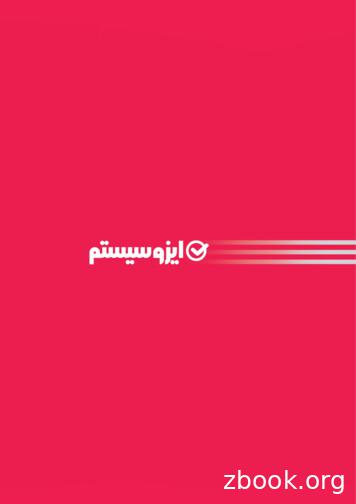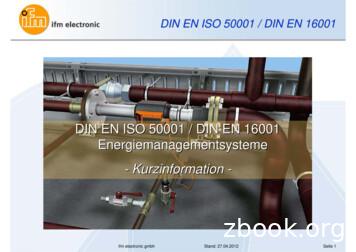White Paper - ISO 50001:2018 Revision
White PaperRevision of ISO 50001 What changes does ISO50001:2018 bring?DIN EN ISO 50001, the international standard for systematic energy management, came into force in 2011. Five years later,work began on the revision and ISO 50001:2018 was published in August 2018. Companies currently certified according toISO 50001:2011 should prepare early for the changeover. This paper aims to provide information about the most importantchanges and practical courses of action.Significant changes to ISO 50001:2018Chapters of the High Level Structure comprise:Among the major changes in ISO 50001:2018 is the imple-1.mentation of the High Level Structure (HLS), which has2. Normative referencesbeen incorporated into all new and revised ISO standards.3. TermsThe High Level Structure was introduced in 2012 by the4. Context of the organizationInternational Organization for Standardization (ISO). This5. Guidanceuniform common structure primarily facilitates the inte-6. Planninggration and application of various management standards.7.In addition, it provides a better understanding of different8. Operationmanagement systems.9.Page 1 / 5Scope of applicationSupportPerformance evaluation
Direct comparison of ISO 50001:2011 and ISO 50001:2018 (NewAmendment)ISO 50001:2011ISO 50001:2018Introductory remarksIntroductory remarks1Scope1Scope2Normative references2Normative references3Terms3Terms4Context of the organization4.1Understanding the organization and its context4.3Defining the scope of the energy management system4.4Energy management system5.1Governance and obligation4.3Defining the scope of the energy management system5.1Governance and obligation7.1Resources5.1Governance and obligation5.3Roles, responsibilities and authorities in the organization4Requirements for an energy management system4.1General requirements4.2Responsibility of management4.2.1 Top management4.2.2 Management representative4.3Energy policy5.2Energy policy4.4Energy planning6Planning4.4.1 General information6.1Measures to deal with risks and opportunities4.4.2 Legal regulations and other requirements4.2Understanding the needs and expectations of interestedparties4.4.3 Energetic evaluation6.3Energetic evaluation6.1Measures to deal with risks and opportunities4.4.4 Energetic starting base6.5Energetic starting base4.4.5 Energy performance indicators6.4Energy performance indicators4.4.6Strategic and operational energy goals and energymanagement action plans6.2Objectives, energy goals and planning to achieve them4.5Introduction and implementation7Support8Operation4.5.1 General informationPage 2 / 5
(NewAmendment)ISO 50001:2011ISO 50001:20184.5.27.2Competence7.3AwarenessSkills, training and cumentation7.5Documented information7.5.1General information7.5.2Creating and updating7.5.3Control of documented information4.5.5Sequence steering8.1Operational planning and control4.5.6Design8.2Design4.5.7Procurement of energy services, products, equipmentand energy8.3Procurement4.6Review9Performance evaluation4.6.1Monitoring, measurement and analysis9.1Monitoring, measurement, analysis and evaluation ofenergy-related performance and of the EnMS6.6Planning of energy data collection4.6.2Assessment of compliance with legal requirements andother provisions9.1.2Assessment of compliance with legal requirementsand other provisions4.6.3Internal auditing of the energy management system9.2Internal Audit4.6.4Non-conformities, corrections, corrective and preventiveactions10.1Non-conformity and corrective actions4.6.5Records controlling7.5Documented information (see Documentation above)4.7Management evaluation (Management review)9.3Management evaluation10.2Continuous improvementFurther innovations of ISO 50001:2018 at a glance: Stronger demands on top managementas establishing energy performance indicators (EnPIs) Systematic consideration of opportunities and risksand energy baselines (EnBs) Even greater focus on energy assessment: Determination and inclusion of all relevant internal anddemonstrating continuous improvements in energy-external parties and topics, as well as their requirementsrelated performance, in line with the Plan, Do, Check,for the energy management systemAct (PDCA) cycle, by identifying key consumers, as wellPage 3 / 5
1234PlanDoCheckAct Defining energy policy andstrategy Identifying responsiblepersons Recording and analyzingenergy use Developing an action plan Prioritizing and implementingeffective measures, energypolicy, and strategy EnMS Sensitization andTraining EnMS Documentation Check implementedmeasures Identify improvementmeasures Evaluation by topmanagement Management review Correct identifiedvulnerabilitiesWhat doesn’t change?The core concepts of ISO 50001 were not changed, only the Find out more about the requirements of ISOidentified weaknesses were eliminated. The new standard50001:2018. If you are already certified according toalso supports organizations in continuously improving theirISO 50001:2011, the changes are of particular interestenergy performance in terms of energy efficiency, energyto you.consumption, and energy use by implementing an energy Identify gaps in your management system and the areaswhere change is needed.management system (EnMS). Make sure that the relevant persons in your companyPreparation for the transition to ISO 50001:2018are informed about the new requirements and are ableStart to prepare in time for the transition process to ISOto understand them.50001:2018.Would you like to find out more about certification according to the new ISO 50001:2018 for efficientenergy management? We support you in converting to the new standard. Contact us today!Page 4 / 5
Transition period to ISO 50001:2018With the publication of ISO 50001:2018 in August 2018, thetransition to ISO 50001:2018 at an early stage.International Accreditation Forum (IAF) has set a transi-From February 21, 2020, 18 months after the publication oftional period of three years. Until then, both the old andthe new standard, audits (initial, surveillance and recertifica-the new standard are valid. Companies that are already ISOtion audits) may no longer be carried out according to the old50001:2011 certified are now required to change their certifi-standard. This may mean that the transition period for somecate during this period. At the end of the transition period oncompanies will be shorter than three years. For companiesAugust 20, 2021, all ISO 50001:2011 certificates will lose theirthat do not yet have a certification for an energy managementvalidity. It is therefore advisable to plan and implement thesystem, it is advisable to opt for the new standard immediately.August 21, 2018February 21, 2020August 20, 2021Publication ofISO 50001:2018Audit stopISO 50001:2011End oftransition periodRequest your individual offer for the certification of your EnMS according to ISO 50001 now!Other services from which you benefitThe DEKRA seal of excellenceYou also have the opportunity to have further quality, envi-Signaling maximum quality andronmental and safety management systems, e.g. ISO 14001,reliability – across different industriesISO 45001 and IATF and their combinations, certified by us.and internationally - the DEKRA sealOur portfolio includes more than 40 accreditations! In addi-is an excellent hallmark and marketingtion, the DEKRA Group provides comprehensive services toinstrument which sets you apart fromstrengthen quality management:the competition. Use it to show yourcustomers and business partners the Evaluations for compliance with own rules, e.g. suppliervalue of what you offer. We are here torequirementshelp you.Training and education, e.g. quality managementrepresentative Personal certifications, e.g. of your quality manager Product testing and certification, e.g. EMV, CE, GS forelectrical and electronic devicesDEKRA AuditPage 5 / 5Mailaudit@dekra.comWebwww.dekra.com/audit
Significant changes to ISO 50001:2018 Among the major changes in ISO 50001:2018 is the imple-mentation of the High Level Structure (HLS), which has been incorporated into all new and revised ISO standards. The High Level Structure was introduced in 2012 by the International Orga
ISO 50001:2018 TIMESCALES ISO 50001:2018 was published 22 August 2018 and is the replacement for ISO 50001:2011. For organizations currently using ISO 50001:2011 there is a three-year transition period to switch to ISO 50001:2018. STRUCTURE OF ISO 50001:2018 The structure of ISO 50001:2018 follows the high level structure being applied to all .
Ref.No.EN ISO 50001:2018 E National foreword This British Standard is the UK implementation of EN ISO 50001:2018. It is identical to ISO 50001:2018. It supersedes BS EN ISO 50001:2011, which is withdrawn. The UK participation in its preparation was e
edition of the ISO 50001 energy management system standard was released in 2018. After 20 August 2021, following a three-year transition period, ISO 50001:2011 certificates will no longer be valid. High-Level Structure ISO 50001:2018 is based on the High-Level Structure (HSL), which has been established as
implementing ISO 50001 2. Can be expected to achieve full conformance to ISO 50001, or is a less rigorous approach needed . 3. Find value in third-party certification of ISO 50001 conformance . 1 See US DOE’s . www.superiorenergyperformance.net
1. Energy Management System Conformance to ISO 50001 Energy Management Standard 2. Energy Performance Improvement (5% minimum over 3 years 7 ISO 50001 Components in place: Baseline Policy Plan Team/Leader Superior Energy Performance Single facility ISO 50001 conformance with validated energy pe
ISO 50001 certification were provided. The plant had already started complying with the U.S. Management System for Energy (MSE 2000) standard . before developing an EnMS. MSE 2000 is widely seen as the forerunner of ISO 50001. “Starting with MSE 2000 meant moving to ISO 50001 certific
internationale Norm EN ISO 50001 ersetzt, welche in Deutschland als DIN-Norm „DIN EN ISO 50001“ veröffentlicht ist. Die neue ISO 50001 beinhaltet die Anforderungen der DIN EN 16001, geht aber über diese hinaus. Zusätzlich legt sie den Fokus auf Energie-Leistung
The ISO 50001 approach to energy management is based on a Plan-Do-Check-Act (PDCA) continual improvement process. Figure 1 shows how the key components of ISO 50001 map to the PDCA process. Important components of an ISO 50001-conformant En























